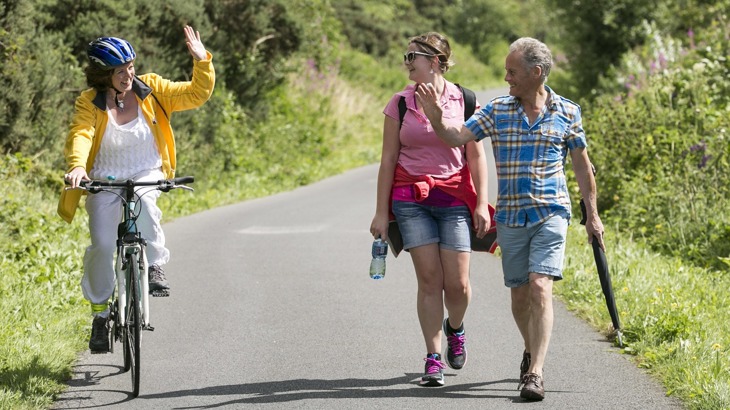The Traffic-free routes overview is part of the Sustrans traffic-free routes and greenways design guide. It covers the key principles in ensuring inclusive design and understanding the functions of traffic-free routes.

Key principles
- Ensuring designs are inclusive
- Environments can be disabling
- Understanding the functions of traffic-free routes
1.1. Inclusive design
1.1.1.
Traffic-free routes must be planned, designed, built and maintained to be inclusive. An inclusive route will provide convenient and unimpeded access for all types of user.
These users will include those walking and wheeling, as well as those riding bikes and, where possible, horses. Each of these users has different and specific needs. A route that only considers the needs of one specific user group will be less successful than an inclusive route.
1.1.2
The Equality Act 2010 places duties on those who make changes to the built environment. Therefore, those responsible for the planning, design, construction and maintenance of traffic-free routes should:
- Remove inequality and discrimination where it exists and promote equality within designs
- Advance equality of opportunity by facilitating those who face greater challenges
- Consider provisions that are proportionate and relevant to the barriers faced
- Address adversity using evidence
- Address the requirements of the Act with rigour and an open mind
- Ensure follow-up measures are not required
1.1.3
Environments can be disabling by restricting movement and access to services and goods. An enabling environment will improve movement and access to services and goods.
Unfavourable treatment due to a person’s ability or perceived difference is discriminatory. Enabling routes will not discriminate against users with protected characteristics. Therefore, traffic-free routes must be planned, designed, built and maintained to be enabling.
1.1.4
A perceived lack of safety is a major barrier to active travel. It is therefore important that designers address both physical and personal safety barriers. For many people, traffic-free routes by their nature are not considered safe.
Their position away from roads, streets or buildings reduce opportunities for passive surveillance. And at certain times of the day low levels of use may also attribute to creating a poor perception of safety.
It is not always possible to address these concerns through design but there are measures that can improve perceptions of safety. These include:
- Increase the number of legitimate path users through behaviour change measures
- Provide high-quality lighting
- Create frequent access/exit points
- Provide and maintain clear views
- Remove potential dark spots.
1.1.5
Planners and designers must consider all potential users of a route. They must remember that users can be disabled by their environment.
Removing obstructions to inclusivity at a scoping / concept stage is critical to ensuring designs are enabling.
1.2. Function of traffic-free routes
Traffic-free routes play an important role within the transport network. They can serve utility, recreation and tourism functions. Their versatility encourages and inspires people to travel by non-motorised means.
1.2.1
Traffic-free routes should have a coherent purpose within a wider transport network. It is important that they link residential areas, employment areas, schools, transport hubs, healthcare and leisure facilities.
1.2.2
Depending on their function, a traffic-free route could take many forms. Routes with a high recreation and leisure function could consist of a shared space. Routes with a utility function could be separated, with space dedicated to different user groups.
1.3. Types of traffic-free routes
1.3.1
Traffic-free routes can be developed within a range of linear corridors or open spaces. Typical types of routes and the challenges that designers should consider are set out below:
1.4. Route planning
1.4.1
The introduction of a traffic-free route should form part of a network-wide plan. This will ensure that existing and proposed routes are coherent and address the travel needs of an area.
The vision of the plan should be to connect trip generators for all users. Trip generators will include education sites, retail, healthcare facilities, businesses and public transport facilities.
Talk to Local Authorities and stakeholders to understand the transportation context of an area. This can include discussing planned developments or changes in land use.
1.4.2
A network-wide plan is useful for understanding budget, programme and implementation priorities. The plan can also assist in helping understand existing inclusivity challenges across the network.
The plan may form the starting point for a Traffic-free Route Scheme Assessment, which will assess the predicted benefits of a route against implementation costs. This exercise will confirm whether investment in a route is viable.
A good network plan can serve to highlight opportunities arising from land-use development. Transport projects and routine highway maintenance can also serve to enhance a traffic-free route network.

